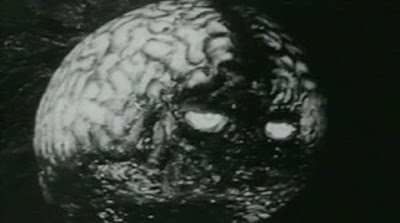The Brain from Planet Arous (1957) d. Nathan Juran (as Nathan Hertz) (USA) (71 min)
“Recognized nuclear scientist” Steve March (John Agar) and his way-too-young assistant Dan Murphy (Robert Fuller) pick up some troubling radiation activity on their, ahem, Nucliometer, and determine that the source of the Geiger-jiggering is none other than the ominously named Mystery Mountain (where viewers have seen a bright floating light land and explode during the opening credits). They pack up their equipment and drive out into the blazing hot desert to investigate – leaving Steve’s fiancee Sally Fallon (Joyce Meadows) to clean up the dishes from lunch – and encounter a flagitious floating flock of megalomaniacal gray matter calling itself Gor (voiced by Dale Tate). Seems Gor has escaped from his (despite its limited anatomy, this is very much a male presence) home world of Arous and is now bent on dominating ours, starting with the overtly hostile act of frying Dan and then taking over Steve’s body in order to a) threaten the world’s leaders with annihilation and b) sexually assault Sally every chance he gets. Meanwhile, Arous has sent another airborne brain, the intergalactic police officer Vol (also voiced by Tate), who allies forces with Sally, her father John (Thomas B. Henry), and their faithful dog George to deal with the mental menace from beyond the Milky Way. May the best frontal lobe win!
Starting with its title, this silly slice of low-rent creature feature announces itself as perhaps not the most frightening entry in the busy 1957 drive-in sci-fi sweepstakes, a suspicion that is confirmed once we catch a glimpse of the eponymous threat which resembles nothing so much as a brain-shaped balloon – with eyeballs, no less – motored about on a string. (Adding to the mirth, Gor and Vol are played by the exact same prop, never onscreen at the same time). Yet there is a certain charm to the proceedings, with any number of already well-worn tropes trading beats in the Bronson Canyon sun, including sex-starved aliens on the prowl for Earth chicks, random radioactivity, body snatching (both humans and animals), and government-toppling telekinesis.
The story behind Brain’s origins are hardly ground-shaking; producer/cinematographer Jacques Maquette, looking for a way to break into the business, banged out a treatment based on Hal Clement’s short story “Needle” and recruited his pal Ray Buffum to turn it into a screenplay. At that point in time, science fiction was king, and one has to admire the blatant exploitation elements in the title: Arous looks like “arouse” (heh heh) and is pronounced like “Eros,” the mischievous Greek god of love and sex, which is then paired up with that most mysterious of squishy human organs. Maquette had his story, and now just needed the right person to helm the project.
Enter a certain Romanian-born Oscar-winning art director (for John Ford’s How Green Was My Valley) who was just starting to make a name for himself behind the camera. Nathan Juran made his directing debut in 1952 with The Black Castle, starring Boris Karloff and Lon Chaney, and followed that up with The Golden Blade with Rock Hudson (1953), three titles with real-life WWII war hero Audie Murphy, and Law and Order (1953) and Hellcats of the Navy (1957), both starring Ronald Reagan. Perhaps recognizing that Brain was not going to raise his industry stock but still needing to pay the rent, Juran elected to use his middle name, Hertz, for his onscreen billing (much to the Director’s Guild chagrin once they found out).
Considering he was poised to become one of Ray Harryhausen’s frequent collaborators (20 Million Miles to Earth, The 7th Voyage of Sinbad, and First Men in the Moon), it’s perhaps no surprise that we see flourishes of Juran’s visual imagination, most emphatically in the shot of Steve’s distorted Gor-possessed face through the inverted bottled water dispenser. (A shot which he would repeat in the following year’s Attack of the Fifty-Foot Woman. Because if it works the first time….)
Juran, while no auteur, proved an efficient craftsman and, in addition to that same year’s The Deadly Mantis, Jack the Giant Killer (1962), and the other aforementioned genre titles, he steered the course for such enjoyable TV fare as Voyage to the Bottom of the Sea, The Time Tunnel, Valley of the Giants, and a slew of Daniel Boone episodes. Sadly, his swan song, 1973’s The Boy Who Cried Werewolf, which reunited the director with his Sinbad/Jack star Kerwin Matthews, feels like a threadbare small-screen outing with its minimal production values and shabby day-for-moonlit-night shots.
Agar, whose name was already synonymous with 1950s sci-fi thanks to his appearances in Universal’s Tarantula, Revenge of the Creature, and The Mole People, was a natural choice to play our lead. He’s certainly in his element whenever playing the likable Steve (despite the fact that we’re never entirely convinced of his scientific acuity), but whenever under Gor’s thrall, Agar really commits to the dark side, chortling like a Bond villain whilst exploding aircraft or lustily sneering and pawing at Meadows. “A performer with limits,” as some might charitably put it, the former Mr. Shirley Temple was by all accounts a congenial sort who always did his best and rarely complained. However, here his fiercest acting challenges came in the excruciating painful form of makeup man Jack Pierce’s silver-coated contact lenses; apparently the paint flaked off in Agar’s eyes, nearly blinding him.
The rest of the cast is up to the task, with Meadows performing in her second of three pictures alongside Agar, (1956’s Flesh and the Spur and 1958’s Frontier Gun). Her Sally Fallon proves to be the actual hero of the piece, since Steve is essentially helpless throughout the latter two-thirds of the story, and the actress grounds the fanciful premise with class, courage, charm, and conviction. (I suppose it was too much to ask for her to deliver the cerebrum-smashing blow to Gor’s “Fissure of Rolando” herself, being that she’s just a female, but at least she provides the vital clue for Steve.)
After years of knocking around Hollywood, playing background roles in such notable productions as The Ten Commandments, Julius Caesar, and Gentlemen Prefer Blondes, Brain represented one of third-billed Fuller’s first credited screen roles. Amiable and attractive, the young actor eventually found steady work in episodic television, on Laramie (124 episodes), Wagon Train (60 episodes), and as Emergency’s Kelly Brackett (125 episodes). Meanwhile, stalwart character actor Henry should be a familiar face, with nearly 200 credits, as well as scads of background and walk-ons. His genre credits include 20 Million Miles to Earth, Earth vs. the Flying Saucers, Beginning of the End, How to Make a Monster, Blood of Dracula, and The Thing That Couldn’t Die.
On the other side of the camera, it’s worth pointing out that in addition to cranking out giant floating brains, props master Richard M. Rubin earned over 100 credits throughout his career, including Star Trek: The Motion Picture, 9 to 5, Exorcist II, Fat City, Funny Girl, most of Corman’s AIPoe series, and the 1965-66 swimwear trifecta, Dr. Goldfoot and the Bikini Machine, Ghost in the Invisible Bikini, and How to Stuff a Wild Bikini.
Prolific author and film historian Tom Weaver, who has provided commentaries for oodles of classic horror and sci-fi, delivers his reliable blend of enjoyable anecdotes and background information throughout… right up until the 55:00 mark when he hands off the mike to musicologist David Schecter (Monstrous Movie Music). Schecter proceeds to discuss the film’s various music cues for 10 minutes, independent of the onscreen action, a puzzling and intrusive approach for fans of traditional commentary tracks (raises hand) and seemingly better suited to a featurette of its own. But seeing as how Schecter has become part of Weaver’s entrenched ensemble (which also includes Larry Blamire and Gary Prange, who offer random personal reflections and “dramatic interpretations” of certain interview subjects) over the past few years, I guess we’re stuck with him.
With its outrageous set-up and goofy special effects, Brain continued to show its synapses throughout pop culture, including the opening credits for 1990s hit sitcom Malcolm in the Middle. From the opening credits to its final line (where Steve mocks Sally story of Vol, despite the fact that he’s been possessed for over a week!), this is an enjoyable daft Turkey that has the sense to play it straight. (Take note, Sharkado and ilk.)
SPECIAL FEATURES:
Audio Commentary with Tom Weaver, David Schecter, Larry Blamire, Joyce Meadows, and Gary Prange of the Mighty Weaver Art Players performing “dramatic interpretations” of certain interviews.
“Not the Same Old Brain” featuring Joyce Meadows (12 min) (scripted and directed David Schecter) (Undeniably silly featurette, but Meadows is clearly a good sport, even 65 years later)
“Not the Same Old Brain” featuring Joyce Meadows (12 min) (scripted and directed David Schecter) (Undeniably silly featurette, but Meadows is clearly a good sport, even 65 years later)
“The Man Before the Brain: Director Nathan Juran” (12 min) (directed by Ballyhoo’s Daniel Griffith and written by Justin Humphreys, who narrates)
“The Man Behind the Brain: The World of Nathan Juran” (14 min), narrated by C. Courtney Joyner and directed by Daniel Griffith
10-page color booklet with essay by Tom Weaver
The Brain from Planet Arous is available now on Blu-ray from The Film Detective and can be ordered HERE:
https://www.thefilmdetective.com/arous
.



























No comments:
Post a Comment